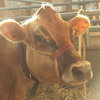Albany Pine Bush celebrates new National Natural Landmark status
The Enterprise –– Michael Koff
New designation: Last Thursday morning at the Albany Pine Bush Discovery Center, Albany Pine Bush Commission Executive Director Christopher Hawver, foreground, gives his opening remarks on the National Natural Landmark status awarded to the Albany Pine Bush Preserve. It is one of 600 designated for this award from the Secretary of the Interior since 1992.
The Enterprise –– Michael Koff
“It’s a New York State treasure,” said David Conners, a representative of United States Senator Kirsten Gillibrand as he recited her remarks to a small crowd last Thursday morning at the Albany Pine Bush Discovery Center on being awarded the National Natural Landmark status. Here, Joe Martens, the state’s Environmental Conservation commissioner and chairman of the Albany Pine Push Preserve Commission, left, and Joe Finan of the National Parks Service and National Natural Landmarks unveil the plaque.
At the 100th meeting of the Albany Pine Bush Preserve Commission last Thursday, a plaque was unveiled announcing the July designation of the Pine Bush as a National Natural Landmark.
The program encourages the conservation of sites that contain outstanding biological and geological resources. National Natural Landmarks are selected for their outstanding condition, illustrative value, rarity, diversity, and value to science and education.
Currently, 597 sites are designated; about half, like the Pine Bush Preserve, are administered solely by public agencies, nearly one-third are owned entirely by private parties, and the remaining are owned or administered by a mixture of public and private owners, according to the National Park Service. New York has 28 sites, ranging in size from 10 acres to, like the Pine Bush Preserve, over 3,000 acres.
The unveiling honors last Thursday went to the state’s Environmental Conservation commissioner, Joe Martens, and Joe Finan of the National Parks Service. After they and a variety of other officials had made speeches, the pair stood on either side of the bronze plaque to peel down the paper cover.
“We have an extraordinary tool in our backyard,” said Martens.
The 3,200-acre preserve provides homes for many plants and animals, containing 55 New York State-designated wildlife Species of Greatest Conservation Need, including the federally endangered Karner blue butterfly.
David Conners, a representative for Senator Kirsten Gillibrand — the senator helped secure the designation — called the Pine Bush “a New York State treasure.” It was chosen because of its unique combination of pitch pine and scrub oak barrens and its dunes made from wind-moving sand that has accumulated in glacial Lake Albany after the Wisconsin glacier melted 12,000 years ago.
The commission’s executive director, Christopher Hawver, said that the Albany Pine Bush is the best example of wind-derived inland sand-dune landforms in the northeastern United States.
The preserve allows study of the natural history of the pine bush and “significant geological episodes of radical climate change,” according to the National Park Service, which administers the National Natural Landmark program.
The Albany Pine Bush dunes are different from those in other pine barrens, said Neil Gifford, the commission’s conservation director. He explained, in a release from the commission, “Other pine barrens are on relatively flat sand plains or ridges of bedrock. The sand dunes create many different habitats by providing unique fine-scale combinations of light, temperature and humidity.”
Gifford added, “This is why the Albany Pine Bush supports more types of plants and animals than other pitch pine - scrub oak barrens. The valleys between dunes support recurring frost throughout spring months; north-facing dune slopes are cooler than those facing south, and there tends to be more moisture at the base of the dunes than the ridges. The dunes also lay the foundation for the wildland fire that drives pine-barrens ecology; in many cases, the very adaptations that help plants survive dry sandy soils make them more flammable.”


